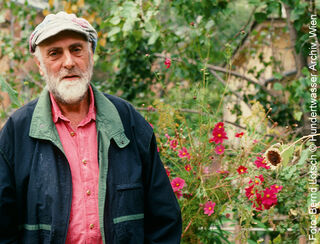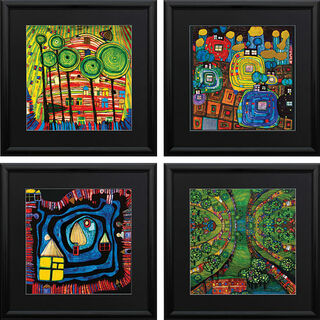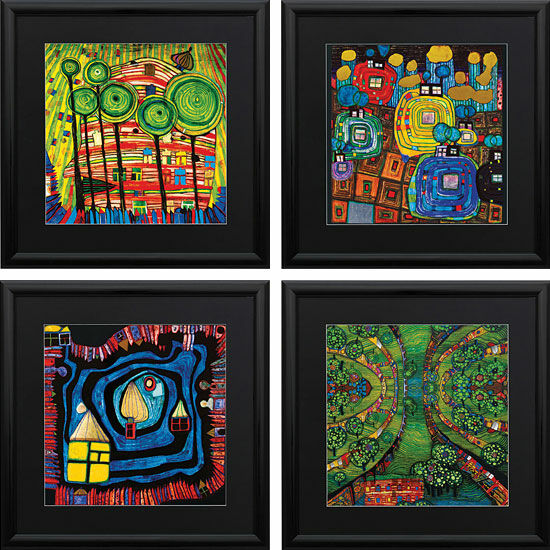Set of 4 pictures
Set of 4 pictures
Quick info
4 reproductions | foil stamping | framed | passe-partout | glazed | size 59 x 59 cm each
Detailed description
Set of 4 pictures
Hundertwasser's use of colour is one of the things that makes his work so unique. He uses it instinctively (according to the well-known art historian Wieland Schmied) and achieves the greatest possible effect with somnambulistic certainty. The deep black lacquered solid wood frame and the black passe-partout with white bevelled edge make Hundertwasser's colours shine brightly. High-quality reproductions in 7 to 9 colours, refined in an embossing process with highly light-refracting metal foil and partially coated with partial UV varnish. Size 59 x 59 cm.
The set includes "(745) Blobs Grow in Beloved Gardens", "(814) Pavillions and Bungalows", "(808) End of the Waters", and "(781) Green Town".
The displayed works of art are protected by copyright. In particular, it is not permitted to copy, edit, print or publish these illustrations. Violations will be prosecuted according to civil and criminal law.
This set contains the following products

About Friedensreich Hundertwasser
1928-2000
Hundertwasser is one of the most internationally renowned artists of our time. His worldwide reputation was already established in the 1960s. Followed by an eventful and evocative career. His aura and power emerged from his painting and multifaceted work.
Organizing demonstrations, speeches, happenings and campaigns, addressing ecological issues, advocating a life in harmony with nature, manifestos for nature, standing up for a more humane architecture and the improvement of people's lives.
Hundertwasser originated projects such as the tree tenants, the roof afforestation, the regreening of cities, the humus toilet, the restoration of social values and the natural cycles. He was an admonisher against environmental pollution, against the dangers of nuclear energy, against natural degradation and the destruction of natural heritage, and in favour of a waste-free society.
Hundertwasser has been engaged with architecture since the 1950s. On the occasion of the inauguration of the Hundertwasser House of the City of Vienna (1986), he said: "We are again experiencing a turning point where old and rigid values in architecture and urban developement are increasingly being questioned. The straightness and uniformity of Bauhaus architecture is coming to an end because it is callous, sterile, cold, heartless, aggressive and emotionless. The era of absolute rationalism is coming to an end. The new values are enhanced quality of life, not standard of living. Longing for romance, individuality, creativity, especially creativity and living in harmony with nature."
With Friedensreich Hundertwasser, our epoch has found the most imposing challenger of totalitarian thinking, whether it concerns nuclear energy, genetic manipulation, environmental protection or the design of our living space. Hundertwasser lived completely in harmony with his view of things and opposing the contradictions of post-industrial society. Hundertwasser's significance is his art that produces beauty: a message of natural harmony, peace and joy.






